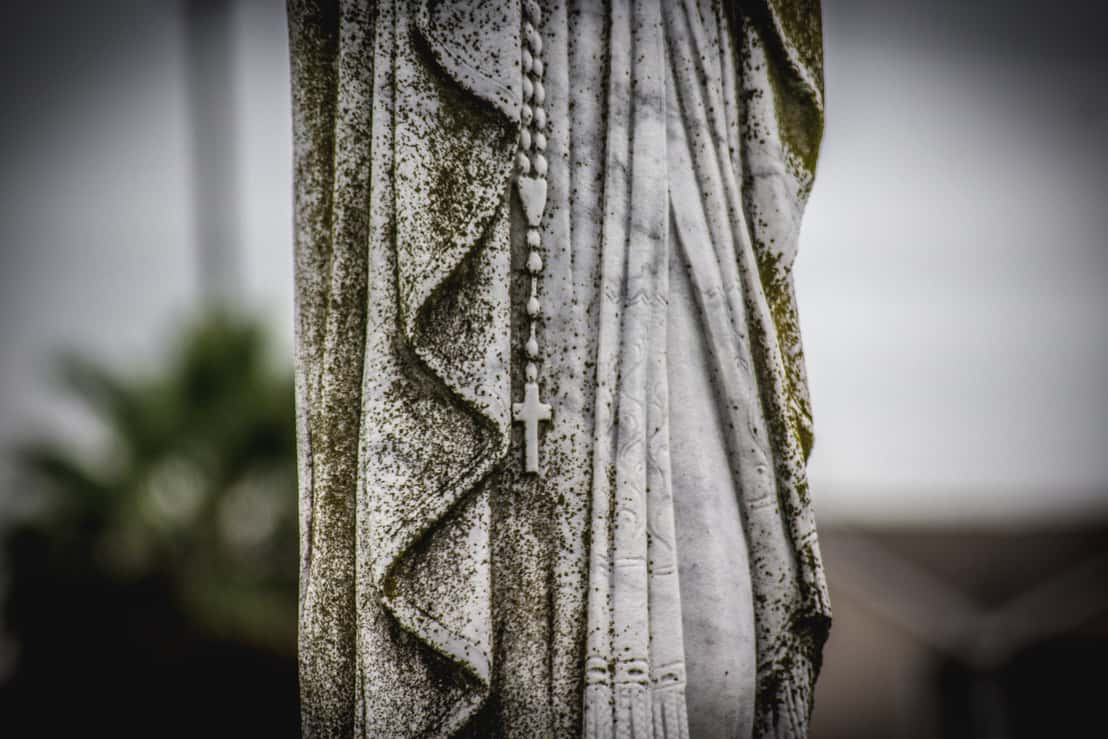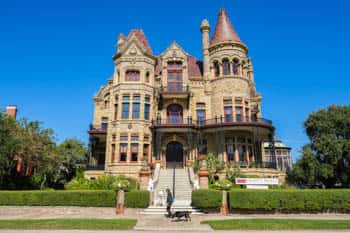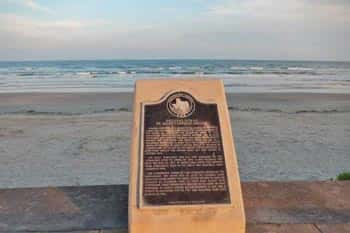Broadway Streets between 40th & 43rd, Galveston, Texas
Plotted between 1839 and 1939, the Broadway Cemetery District incorporates seven distinct cemeteries. Don’t be fooled by the surface, though: these urban burial grounds are three layers deep. Although there are an estimated 12,000 grave markers, there are three times the amount of bodies buried below. As for the inhabitants – think Elize Roemer Alberti, who newspapers called “the demented mother” for murdering her four children, or Nicaragua Smith, the arsonist and Confederate soldier executed by firing squad. Smith was buried in an unmarked grave where he was formally put to death. Alberti? Buried with the same children that she fatally poisoned. Smith and Alberti are just two haunted hosts of Galveston’s necropolis, however. What – or who – lurks beneath?

Established in 1839, Galveston’s cemetery complex replaced a more temporary burial fashion. Before the Broadway Cemetery District, settlers would often bury their dead in sand dunes near the Gulf of Mexico. Yet the sand would shift or reshape, uncovering coffins and migrating markers. These burial markers were typically hand-carved or constructed from salvaged materials, making them unsustainable against Galveston’s natural catastrophes.
The sand dunes were a simple way to inter the dead, yet ultimately ineffective. If you wanted your beloved to stay buried, that is.
The Galveston City Company soon recognized that these burying methods were unfit for extensive, long-term interments. They were especially unfit for the Yellow Fever Epidemic, which had claimed 250 Galveston lives in 1839 alone. The “Saffron Scourge” had saturated this hard-hit city.
So, to improve burial conditions, the Galveston City Charter was tasked with the creation of a public burial ground. That’s where the Broadway Cemetery District comes in.
The Galveston City Company donated four blocks of land for the cause, erecting the Old City Cemetery and adjacent Potter’s Field. These burial grounds were, at the time, outside of city limits. Their location was then particularly appropriate – remote from residential and commercial properties, yet near enough to transport bodies.
Those who were buried in the dunes beforehand were exhumed and reinterred within the new cemeteries. Not everyone made the relocation, of course. Some were too disfigured by the elements. There were newly discovered residents, too – unidentifiable bodies unearthed from unnamed graves.
Two more blocks of land were donated in 1844, allowing for the creation of the Trinity Episcopal Cemetery and the Old Catholic Cemetery. Five additional cemeteries were established throughout the nineteenth and twentieth centuries, together comprising the Broadway Cemetery District.
Yet grade raises occurred throughout the twentieth century with burials occurring above burials. Because of these man made elevations, some graves of the Broadway Cemetery District are three bodies deep.
At 200 years old, Galveston’s Old City Cemetery is the region’s earliest. The burial ground initially allotted additional space for the German Lutheran Church, the Independent Order of Odd Fellows, and the Protestant Orphans Burial Ground – making for a distinctive, diversified demographic. It’s no surprise that the Old City Cemetery is also considered the district’s most unnerving graveyard.
For starters, the Old City Cemetery is the final resting place of Elize Roemer Alberti. Alberti murdered her four children in 1894, earning her the moniker, “the demented mother.” It’s suspected that she suffered from severe postpartum depression, which may shed light on why she poisoned her four children. Alberti’s method? Morphine in wine. That’s right, she gave her young children wine (and morphine).
Alberti attempted to justify her action by explaining that she had been “ill for the last eight months.” She’s even quoted saying, “I could not fill my obligations to my babies. They are better off." Whether Alberti was a stone cold killer or was misguided though well-meaning is anyone’s argument. The tragedy of her tale, however, remains irrefutable.
After the murders, Alberti was sent to the San Antonio Asylum. She was ultimately returned to Galveston upon her release, where she committed suicide. Later interred in the same burial plot as her children. Alberti’s death was as grievous as Alberti’s life. She also makes for one of the few instances where a murderer is buried alongside their victim.
Established in 1839, Potter’s Field is Galveston’s second oldest cemetery. Otherwise known as a pauper’s grave or common grave, a Potter’s Field was historically where “indigents are buried.” The origins of the moniker come from the New Testament. For example, Judas is interred in a “Potter’s Field,” the “burying place for strangers.”
Galveston’s is no exception, so it’s no surprise that the few gravestones in Potter’s Field are unmarked. Records reveal that nearly 1,000 interments occurred in Potter’s Field, however. A Confederate Potter’s Field was likewise erected within the burial grounds after the Battle of Galveston in 1863, providing formal burial space for veterans. If you were without money or family, you could still rest easy.
In 1939, Potter’s Field was renovated, refurbished, and enlarged. To further the sense of renewal, the City of Galveston renamed Potter’s Field to Oleander Cemetery. Their renovations didn’t rid them of their haunted hosts, however…
One of Oleander’s most infamous inhabitants is, no doubt, Nicaragua Smith. Smith was an arsonist and burglar who abandoned the Confederate Army in 1862. Ultimately tried for desertion, he was executed by a firing squad on the 8th of January, 1863.
New Cahill Cemetery is often remarked upon for its splendid, sprawling landscape. Yet these cemeteries are more than a pretty picture. Erected in 1900, though later renamed “Evergreen Cemetery,” these two burial grounds were meant to memorialize those who perished in the Great Storm of 1900. It’s suspected to contain 900 burials total, though as many as 12,000 died from the disaster. There’s no doubt that a few lingering souls idle about.
The Episcopal Cemetery was established in 1844, though enlarged in 1864. Its haunted history is self-evident: Confederate and Union soldiers were often buried in the Episcopal Cemetery after the Battle of Galveston in 1863.
The cemetery’s monuments were upheaved and elevated during a grade raising of 1904-1910, though the graves were left undisturbed. That’s what’s alleged, at least.
Like the Episcopal Cemetery, the Old Catholic Cemetery was established in 1844. The two cemeteries were organized alongside one another, catering to families of different faiths. Approximately 900 souls call the Old Catholic Cemetery home.
Established in 1867, the Old Cahill Cemetery was initially named after the sexton M. Cahill. It was later renamed the New City Cemetery after The Great Storm of 1900, which had desecrated the City of Galveston. Galveston thought that renaming the burial ground would inspire or galvanize the city, instilling a renewed sense of optimism. So, in 1900, the Old Cahill Cemetery became the New City Cemetery.
Yet it’s sometimes referred to by its sequestered allotment, the “Yellow Fever Yard.” The Yellow Fever Yard had been initiated in response to the yellow fever epidemic that occurred in 1867 – Galveston lost 725 citizens to the epidemic. The burials occurred so quickly, however, that the deceased were often left unidentified. To this day, their graves remain unmarked.
After the six-year-old son of Isadore Dyer died, a small section of Potter’s Field was allotted to Galveston’s Jewish community. They were able to establish their own private burial ground in 1868, however – the Hebrew Benevolent Society Cemetery. This was at the bequest of Rosanna Osterman, who died in a steamboat explosion the preceding year.
Elize Roemer Alberti and Nicaragua Smith are the district’s most notable haunts, though many more are suspected.
Yet murderers and madmen aren’t the only inhabitants of this urban burial ground: the Broadway Cemetery District likewise inters soldiers and sailors, statesmen and scientists, philanthropists and pioneers. For example, John Allen, Galveston’s first mayor, is interred within the district, as is George Campbell Childress, who authored the Texas Declaration of Independence.
Another notable inhabitant? Noah Noble John. John had survived three shipboard disasters before his untimely death. The Brownsville’s sinking, the Stare State’s burning, the Farmer’s explosion – John was there for all three of them. Does Noah Noble John lurk his landlocked lodging?
The cemeteries grade raising also means that there are those that rest below what we can see. Who lurks beneath the surface?
The Broadway Cemetery District occupies six city blocks, and can be located midtown. As one of the few remaining urban cemeteries, it’s an invaluable location. Whether you’re into philanthropists, pirates, or politicians, the Broadway Cemetery District is a must-see. Do let us know if you encounter any paranormal activity.

One of the most haunted houses in Galveston

Site of great tragedy

Stay at a haunted hotel in Galveston